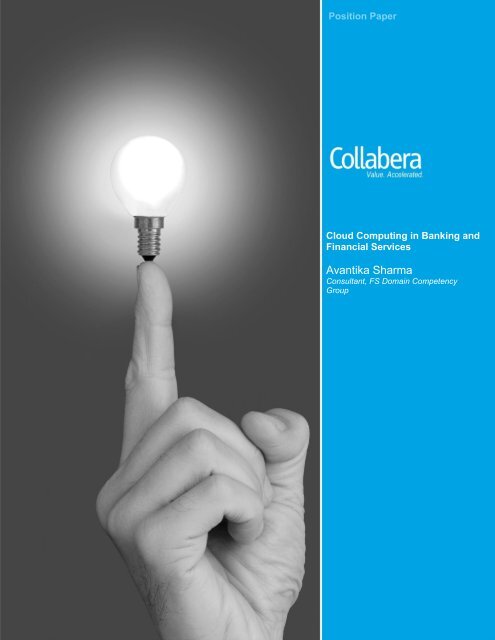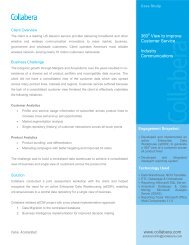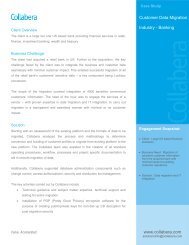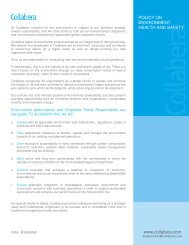Cloud Computing - BFS - Collabera
Cloud Computing - BFS - Collabera
Cloud Computing - BFS - Collabera
Create successful ePaper yourself
Turn your PDF publications into a flip-book with our unique Google optimized e-Paper software.
Position Paper<br />
<strong>Cloud</strong> <strong>Computing</strong> in Banking and<br />
Financial Services<br />
Avantika Sharma<br />
Consultant, FS Domain Competency<br />
Group
Introduction<br />
For many banks and credit unions, building a technology infrastructure to meet current or<br />
evolving business needs is easier said than done. Budget, people, and/or capacity constraints<br />
affect the ability to establish technology capabilities necessary to run and scale operations.<br />
“<strong>Cloud</strong> computing” is an innovative solution for improving technology capabilities by taking<br />
advantage of business applications and computing power made available over the Internet.<br />
Banks and credit unions have been leveraging service bureaus or outsourced core banking<br />
platforms for decades. <strong>Cloud</strong> computing takes the same concept into the modern age with<br />
technologies such as those offered by Salesforce.com, Google, Amazon and Microsoft. The<br />
rapidly growing array of cloud computing options provides an opportunity for banks and credit<br />
unions to reduce their internal technology footprint and gain access to technology built and<br />
managed by third-party experts.<br />
In the current economic conditions, Bankers are under intense pressure to cut costs and increase<br />
returns. While the <strong>Cloud</strong> <strong>Computing</strong> model is still emerging, it is still an attractive proposition<br />
because of the following:<br />
• Capital expenditures are minimal<br />
• Support costs are low<br />
• Reduces Capex and Opex with better ROI<br />
• Applications, like customer relationship management, risk management can be brought<br />
to market relatively quickly<br />
• Banks can focus on their core business as opposed to concerning themselves about<br />
infrastructure scalability<br />
• Better Disaster Recovery capability<br />
• Banks may explore use of cloud computing initially for better performance through peak<br />
demand periods but eventually adoption could spread to other areas<br />
Gartner placed <strong>Cloud</strong> <strong>Computing</strong> at No 2 (Virtualization being 1) in its ranking of Top 10 Strategic<br />
Technologies for 2009.<br />
Although cost is a potential benefit for small companies, the biggest benefits are the built-in<br />
elasticity and scalability, which not only reduce barriers to entry, but also enable these companies<br />
to grow quickly. As certain IT functions are industrializing and becoming less customized, there<br />
are more possibilities for larger organizations to benefit from cloud computing.<br />
Gartner<br />
Value. Accelerated.
Need for <strong>Cloud</strong> in Banking and Financial Services<br />
For financial services organizations, there are<br />
several significant IT concerns that directly affect<br />
bottom line. Not least of these are the excessive<br />
infrastructure costs associated with underutilized<br />
IT resources, high labor costs associated with<br />
manual IT resource deployment processes and<br />
procedures; and potential compliance and audit exposure due to human error<br />
Forrester lists three key benefits to the cloud, starting with speed. SAAS enables businesses to<br />
get up and running in a flash. As per the report, a financial services firm migrated its employee<br />
portal to a cloud-based vendor and launched it in two months, while another firm has spent the<br />
last 18 months building its employee portal in-house.<br />
In short, the cloud is ready-made. Customers don't build; they subscribe and receive services—<br />
including anything from Web conferencing and hosted e-mail to enterprise applications such as<br />
CRM and HRM—immediately.<br />
Two, businesses should ship IT tasks to cloud computing specialists, who "worry about the nuts<br />
and bolts so that you don’t have to." This enables the IT staff to focus on more important<br />
business processes.<br />
Finally, instead of buying hardware, software and consultants to set up and run applications,<br />
businesses can pay a cloud-based provider by the user by the month. Moreover, businesses pay<br />
for only what they use and can terminate the contract.<br />
A common use case for clouds among Financial services clients is that many investment banks<br />
and buy-side firms such as hedge funds will have their private grid infrastructure for such<br />
functions as Monte Carlo simulation and risk analysis hosted in a 3rd Party data center, yet will<br />
need to add capacity on the fly at critical points in the execution of the application.<br />
Benefits from <strong>Cloud</strong> can be accrued in following areas for Banking and Financial services:<br />
• Enterprise content management<br />
o Customer interaction archival and search, e-mail archiving, e-mail security and<br />
document creation<br />
• Back-office activities<br />
Value. Accelerated.
o Example: credit card processing<br />
• Different types of payment processing and consolidation<br />
• Enterprise risk management - IT frameworks for financial services<br />
• Enterprise portals<br />
• XTTPS - Extreme Transaction Processing Platforms.<br />
• XTTPS provides the foundation technology for certain classes of cloud computing and<br />
services as Application-Platform-as-a-Service (APaaS)<br />
• Printing services (printing opportunities in the enterprise)<br />
• Identity management<br />
• Enterprise CRM<br />
• Consumer credit reporting<br />
• Sales force automation<br />
• Customer support systems<br />
• Retail banking and stock trading<br />
• Foreign exchange<br />
• DNS (Domain Name System) management<br />
• Larger storage areas and back up mechanism<br />
• Critical batch job scheduling<br />
o Example: month/year end interest calculations<br />
Business Drivers for <strong>Cloud</strong>:<br />
Better Cash Flow and greater financial visibility: Cash flow follows the realization of benefits<br />
and it offers transparency of costs. By being able to directly charge Financial Firms for resources<br />
used by them business units have a better visibility of the financial costs of IT services. This<br />
typically drives business units to rethink their IT demand and optimize their usage accordingly<br />
Rapid Provisioning and elastic scaling of services: Given recession scenario Financial<br />
Institutions can quickly scale-up or down usage in response to the changing Business needs.<br />
This flexibility helps business to respond to changing business requirements in an efficient and<br />
cost effective way by paying for capabilities<br />
Randy Snook, senior MD, Securities Industry and Financial Markets Association, says: "Often<br />
clients or regulators will call our members firms about a trade that happened several months ago.<br />
New technologies will make this far easier. <strong>Cloud</strong> computing can allow firms to keeping vast<br />
amounts of data online indefinitely and mobile technologies can give brokers instant access from<br />
Value. Accelerated.
anywhere so that they can quickly answer such questions without having to pull out and search<br />
their data archives."<br />
Allow the Bank IT department to focus on competencies that are core to business: By<br />
moving non-critical services on to the cloud, the IT department can shift its focus from tactical<br />
problems such as constant software patches, platform maintenance and other computing issues,<br />
to strategic IT projects<br />
Environmental benefits: Further, the CSPs may transfer the services to a<br />
Virtualized environment in a location where the energy is ‘greenest’ and leads to higher utilization<br />
of the computing power and lower wastage from idling.<br />
Current Deployment:<br />
Payment Applications - Gartner had indicated it as one of the near term <strong>Cloud</strong> Opportunities<<br />
2012<br />
In today’s public cloud, payment provider’s, such as Amazon’s FPS, assume merchants<br />
want to build their own specialized payments system to sell goods and services. They<br />
even offer advanced features, such as programming aids that allow easier integration<br />
into web sites, tokens, and shopping cart tie in, with the intention of making payment<br />
solutions as complete as possible.<br />
PayPal offers a defined outsourced payment solutions that can be integrated into<br />
product and service applications by using their standard adaptive payment API’s.<br />
Regardless of what cloud provider is in play, or what client is used, or what the<br />
underlying organization is defined as, or what services are being sold, PayPal’s offers a<br />
solution that simply works, and, at the same time several of the traditional pain points,<br />
such as authenticating, managing tokens, acceptance, third party payments and<br />
settlement are handled and contained within PayPal.<br />
Value. Accelerated.
The Society for Worldwide Interbank Financial Telecommunications (Swift) came up with "eMe", a<br />
cloud-based project at Sibos -- Swift's annual transaction banking conference in Sept ‘09<br />
eMe would allow banking customers to establish a digital lockbox with sensitive personal or<br />
business information, such as credit card numbers. Instead of having to type in the information<br />
each time a consumer or business makes a purchase, a code could be given to the digital<br />
lockbox.<br />
<strong>Cloud</strong> computing, the theme behind the eMe proposal, is basically a way to use the internet to<br />
dynamically increase server or database capacity.<br />
Escrow - Financial services firms are using cloud computing with increasing frequency hence in<br />
order to protect the software they invest in, concept of Software Escrow comes into picture.<br />
Software escrow is the placing of the software's source code with a trusted third party. The<br />
supplier and customer agree that the code will be released in identified circumstances, such as<br />
the supplier no longer being able to support the product. It allows companies to protect and insure<br />
all the data that resides within SaaS applications, protecting against data loss.<br />
SaaS Data Escrow is the process of keeping a copy of critical software-as-a-service (SaaS)<br />
application data with an independent third party.<br />
Value. Accelerated.
Money Management Moves to <strong>Cloud</strong>s – Banking 2.0: There are a number of applications that<br />
manage our finances in the cloud. Few of the online banking apps where we can manage your<br />
bank account, credit card accounts, loans, and brokerage and investment accounts are Mint,<br />
Wesabe, Geezeo, Expensr, MoneyStrands, Xero etc.<br />
Hedge Funds - For many hedge funds, being successful in today's economic environment<br />
requires the ability to process large quantities of data quickly to arrive at good investment<br />
decisions. Traditionally, a fund's ability to process this data has been limited by the amount of<br />
computing and storage resources it could acquire. This meant funds often had to make large<br />
upfront investments in servers, storage, networks, and facilities, with limited flexibility to handle<br />
variable needs.<br />
Putting trading code in the cloud also is supposed to mean delay-which, if your strategies<br />
rely on speed, means you risk losing your edge. But some smaller hedge funds and proprietary<br />
traders are using Amazon EC2's compute cloud to specifically power their trading algorithms,<br />
execute their automated strategies and store the results.<br />
The programs are connected to market data feeds which automatically submit orders to the<br />
brokerage account when appropriate, EC2 is used for actual order submission and automatic risk<br />
and position management, such as hedging, exiting, etc because the servers are in a more stable<br />
environment with respect to both computer and Internet connections than their own office<br />
computers and network can ever achieve, at a similar cost.<br />
Customer Relationship Management - A regional financial services company based in<br />
Oklahoma was able to roll out the new system in less than five months (which included five<br />
weeks of training). According to them, it removes the responsibility of installing, upgrading, and<br />
maintaining all the software from the bank. Ninety-five percent of the commercial bankers in a<br />
particular group use this cloud-based CRM application. <strong>Cloud</strong>-based application has proven to be<br />
easily customized; users can enter or track information in the database without having to learn<br />
new terminology. Indeed, before it adopted the cloud model late last year, less than 60 percent of<br />
the bank's employees were using the CRM database, now 90 percent are using it.<br />
One of the largest financial services holding companies late last year rolled out a new employee<br />
relationship-management application to more than 2,000 employees in 77 days. Once up on the<br />
cloud, it had a better view of client data, giving it a better handle on which accounts were<br />
profitable and which weren't. Armed with more information, it was able to increase its capital<br />
markets fees by 67%, treasury fees by 29%, and wealth management referrals by 31%,<br />
according to information provided to him by the bank.<br />
Value. Accelerated.
Cash Management- A bank in Louisville wanted to deliver lender and cash-management support<br />
products based on the software as a service model; they quickly leapt on the nascent cloud<br />
concept because "it would give banks the easiest implementation and adoption" According to the<br />
company's CEO, while interest is high, most of his clients are community banks with less than $1<br />
billion of assets. For larger banks that have long run their applications in-house, the idea of<br />
running applications under a service model, and sharing resources (potentially with companies in<br />
other industries) could be a little more difficult to swallow, he says.<br />
One of the largest banks in South Africa had a problem that any user service request, for e.g. any<br />
new application, development environment, test environment, production environment—it was<br />
taking a lot of time for the IT department to deliver. This was frustrating the business users and<br />
making the bank slow to respond. Every time the bank’s IT department had to provision a new<br />
environment, it had to take the time away from a project and go in and put a DR or additional test<br />
environment in place and while doing that projects were suffering. Using <strong>Cloud</strong>Burst the bank’s IT<br />
department can now provision the environment overnight, the results are available in the morning,<br />
the IT staff checks a couple of things, ensure that it’s all OK and get back onto the project work.<br />
Risk Management – Leading European global banking and financial services firm is using an ondemand<br />
computing service to run its risk application. It pays for the instances based on the<br />
amount of cycles, bandwidth and storage they use, hence can offload the capacity. So if a bank,<br />
running the risk application- essentially lots of machines doing Monte Carlo - in the cloud means<br />
they can go down the economic curve.<br />
One of the largest financial conglomerate uses cloud computing as a good fit for "all applications<br />
that are load-intensive and read-intensive," such as risk management, quantitative analysis,<br />
developing trading algorithms, and managing internal compliance - because the cloud model<br />
utilizes resources only when and as much as its needed. (The model does not work as well for<br />
tasks like transaction processing, where processing needs are persistent and steady.)<br />
<strong>Cloud</strong> Delivery Model Architecture<br />
Current Deployment of <strong>Cloud</strong> incorporates combination of providing Hardware Infrastructure,<br />
Solution Stack as well as the Software Solution. Although cloud-based ecosystems allow for a<br />
wide range of service delivery models, three have become most prominent –<br />
Software as a Service (SaaS) is a model of software deployment whereby a provider hosts an<br />
application to customers for use as a service.<br />
Platform as a service (PaaS) is a model of providing computing platform as well as solution<br />
stack as a service.<br />
Value. Accelerated.
Infrastructure as a Service (IaaS) is a model of providing computer infrastructure as a service.<br />
<strong>Cloud</strong> Deployment Models<br />
Private <strong>Cloud</strong> - Intentionally limits access to its resources to service consumers that belong to<br />
the same organization that owns the cloud. In other words, the infrastructure that is managed and<br />
operated for one organization only, primarily to maintain a consistent level of control over<br />
security, privacy, and governance.<br />
Community <strong>Cloud</strong> – This deployment model typically refers to special-purpose cloud computing<br />
environments shared and managed by a number of related organizations participating in a<br />
common domain or vertical market.<br />
Public cloud – Represents a cloud environment that is openly accessible. It generally provides<br />
an IT infrastructure in a third-party physical data center that can be utilized to deliver services<br />
without having to be concerned with the underlying technical complexities.<br />
Hybrid <strong>Cloud</strong> – It is composition of two or more clouds<br />
Key Challenges:<br />
Lack of transparency and compliance: Bank’s audit requirements may stipulate that it retains IT<br />
infrastructure so as to demonstrate effective control on access and overall information security.<br />
As with any innovation, cloud computing also requires a fundamental shift in an organization’s<br />
risk management and therefore audit requirements. In order to satisfy these audit requirements,<br />
businesses may request that the <strong>Cloud</strong> services agreement should take into consideration of<br />
future independent audit and legal or compliance requirements.<br />
Data ownership and Intellectual Property (IP): Secrecy of Data is very crucial to the survivor of<br />
any Financial Institution and Leakage of data and IP is one of the most significant risks a Bank<br />
faces. In a cloud as data/ IP is stored outside company boundaries, there is an increased risk that<br />
data may be used for purposes not originally specified including data search<br />
Implications of data privacy regulations and laws: In a cloud data may be transferred and<br />
stored across different international locations. Various Governments, especially those in the<br />
European Union (EU), have privacy regulations that prohibit transmission of some types of<br />
personal data outside the EU. Additionally, the legal jurisdiction of the data is often defined by the<br />
Jurisdiction of the hosting country, which may have legal implications.<br />
Value. Accelerated.
Investigation of inappropriate or illegal activity may become Uneconomical: In the <strong>Cloud</strong><br />
environment, a single set of customer data may be spread across an ever-changing set of hosts<br />
and data centres. As with auditing, the <strong>Cloud</strong> provider should be responsible for maintaining<br />
meaningful logging and monitoring and the <strong>Cloud</strong> agreement should provide the capability to<br />
perform investigations for suspected illegal/ unauthorized activities.<br />
Limited speed and availability: Access to Internet/ WAN is critical to avail <strong>Cloud</strong> services. The<br />
key factor that a Bank must assess and specify to a CSP is the network latency and uptime. It is<br />
important to agree acceptable latency and availability with the CSP.<br />
Risks around the business continuity and disaster recovery: The quality of organization’s<br />
connection could become the ‘single-point-of-failure’ in <strong>Cloud</strong> computing. The distributed nature<br />
of the data also means that data restoration in a disaster recovery situation will need to be wellplanned<br />
and tested.<br />
Bandwidth and other service costs: Although bandwidth costs have reduced significantly in the<br />
recent years, it can still be high for large applications or data-intensive <strong>Cloud</strong> services. It is<br />
important to consider costs while moving to, as well as operating in the <strong>Cloud</strong> environment.<br />
Limited guarantee on service levels: Overall <strong>Cloud</strong> service levels will be influenced by network<br />
connection. <strong>Cloud</strong> services, the service levels and dispute resolution process will need to be<br />
clearly defined in both the <strong>Cloud</strong> service agreement and network service agreement.<br />
Complex licensing/ charging models: Licensing/ charging models for <strong>Cloud</strong> <strong>Computing</strong> include<br />
single license, multiple users/shared license, temporary or fixed period use, pay-per-use and by<br />
subscription. A Bank requires a strong understanding of business’s IT usage profile and<br />
implementation of an appropriate licensing/ charging model accordingly.<br />
Limited ability to customize and upgrade: For <strong>Cloud</strong>-based software and services, many major<br />
cloud providers release industry standard Application Programming Interfaces (API). The APIs<br />
allow the business to access the <strong>Cloud</strong>’s service through standard interfaces with predefined<br />
functionalities. This limits the level of customization that can be done and can lead to a change in<br />
the end- user experience.<br />
Vendor lock in: Once you host your Services with a particular ‘<strong>Cloud</strong>’ provider and if you are not<br />
careful enough, there is always a chance of lock in.<br />
Value. Accelerated.
Gartner research indicates Security and Control are the most prominent issues and to resolve this<br />
we need to establish trust and openness. Some of the <strong>Cloud</strong> vendors have realized that point and<br />
the action from their side is that they are taking security team from the financial organizations<br />
itself.<br />
Summary<br />
Regardless of the benefits, cloud computing is still being met with resistance from the financial<br />
industry. With apprehensions about security breaches, increased standards (MA 201 CMR 17)<br />
and overall performance, firms tend to discount the cloud model. Given the sensitivity of data in<br />
financial firms, it is understandable that confidence in a virtual system may falter. However, thirdparty<br />
hosts are trying to be well equipped to meet the standards in:<br />
• Data protection measures;<br />
• Firewalls;<br />
• Security checkpoints; and<br />
• Passwords.<br />
Road Ahead:<br />
According to Information Week Financial Services <strong>Cloud</strong> <strong>Computing</strong> survey a vast majority of<br />
capital markets firms that are using cloud computing employ it in areas of general services, such<br />
as general business applications (28 percent); data center space (24 percent); and storage,<br />
archiving and disaster recovery (21 percent). Meanwhile, 41 percent of respondents currently are<br />
evaluating adopting the cloud for application testing.<br />
Fewer firms are using the cloud for financial services-specific applications. Results were equally<br />
split (17 percent) between back-office operations applications, middle-office applications and<br />
client reporting. Most respondents (43 percent), however, said they had no intention of using the<br />
cloud for trading applications or price modeling/valuation<br />
For capital markets firms planning to use cloud technology in the next 24 months, most<br />
respondents (57 percent) said they intend to use a SaaS delivery model, in particular for CRM<br />
and ERP. Forty-eight percent indicated plans to tap infrastructure-as-a-service offerings that<br />
provide raw CPU time and storage resources<br />
Value. Accelerated.
Source- Wall Street & technology<br />
Over the past year, <strong>Collabera</strong> has gained significant experience in building and deploying<br />
applications from the ground up, migrating existing applications to the cloud or building a hybrid<br />
cloud applications that leverages the best of cloud and enterprise’s infrastructure.<br />
<strong>Collabera</strong> has published viewpoint documents that compare cloud vendors on various parameters<br />
segregated based on the cloud delivery model. <strong>Collabera</strong> has also created two technology<br />
demonstrators,<br />
• <strong>Collabera</strong>Space: <strong>Collabera</strong> leveraged Microsoft Azure to build <strong>Collabera</strong>Space<br />
to overcome the typical challenges encountered in a global delivery model. All<br />
stakeholders in a project can access and use the various social application<br />
features in <strong>Collabera</strong>Space like blogs, forums, knowledge base, chat, geolocation<br />
services to address the day to day operational aspects in any client<br />
engagement.<br />
• <strong>Collabera</strong> mBanking: <strong>Collabera</strong> mBanking is a service that allows users to do<br />
banking transactions on their windows mobile phone without making a call,<br />
using the internet facility. With Microsoft Azure and .Net Services, <strong>Collabera</strong><br />
built a solution that caters to all the business needs of the Customer, one<br />
channel of access is from browser clients communicating with the online<br />
banking application and the other with the handheld mobile device<br />
Value. Accelerated.
communicating with the banking services. This application won an award in<br />
<strong>Cloud</strong> app contest conducted by Microsoft.<br />
In the current market scenario that is primarily based on cost economics coupled with demands<br />
for scalable, flexible and efficient systems that can support varied workloads, cloud computing is<br />
a prime candidate that slots well and can achieve all these and more.<br />
<strong>Cloud</strong> technology has started maturing from its initial experimentation days to being accepted as<br />
a key business enabler for organizations fueling increased demands from businesses, which in<br />
turn means that IT needs to be agile and flexible to meet ever changing business expectations<br />
and that requires a broad based and integrated capability – not just in skills, but across<br />
capabilities, types of engagements and service delivery models.<br />
<strong>Collabera</strong> is geared to meet this very need of customers and offers a broad portfolio of cloud<br />
services to meet your end-to-end needs. Starting with strategic IT advisory services to services<br />
across the application space and infrastructure space, <strong>Collabera</strong> has the capability and<br />
experience to be your cloud partner. We are geared to service you irrespective of where and how<br />
you need the service delivered as we are perhaps, one of the very few companies that can<br />
provide you IT advisory services, meet your staffing needs and at the same time support your<br />
managed services requirement.<br />
Reference:<br />
1. http://www.cloudbzz.com/what-is-cloud-computing/<br />
2. en.wikipedia.org/wiki/<strong>Cloud</strong>_computing<br />
3. http://www.wikinvest.com/concept/<strong>Cloud</strong>_<strong>Computing</strong><br />
4. http://www.finextra.com/fullstory.asp?id=20291<br />
5. Technology Paradigms for the Banking Industry- <strong>Cloud</strong> <strong>Computing</strong> – KPMG<br />
6. Clearing the Air <strong>Cloud</strong> <strong>Computing</strong> By Farhad Javidi<br />
7. Google News<br />
8. Google Apps<br />
9. Salesforce.comForce.com<br />
Value. Accelerated.
www.collabera.com<br />
Value.<br />
solutionsinfo@collabera.com<br />
Accelerated.














